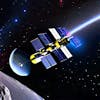S03E34: Solar Secrets Unearthed & Hera's Martian Waltz

Prepare for an astronomical adventure in today's episode of Astronomy Daily - The Podcast. Host Charlie takes us on a thrilling journey, starting with the awe-inspiring revelations of the 2024 total solar eclipse. Witness the unity of community and...
Prepare for an astronomical adventure in today's episode of Astronomy Daily - The Podcast. Host Charlie takes us on a thrilling journey, starting with the awe-inspiring revelations of the 2024 total solar eclipse. Witness the unity of community and science as the Citizen Continental-America Telescopic Eclipse (CATE 2024) experiment captures a high-resolution solar spectacle, while NASA's WB-57F aircraft ascends to 50,000ft for a clear-eyed view of the sun's corona.
Next, we buckle up for the ESA's Hera mission's gravity-defying detour by Mars, a strategic maneuver on its path to investigate the Didymos binary asteroid system. This mission within a mission offers an unprecedented close-up of Mars' moon Deimos, showcasing the versatility of space exploration.
Our quest for knowledge continues with the hunt for water on other worlds. Join us as we delve into the icy mysteries of Jupiter and Saturn's moons, where ice-penetrating radar technology aboard the JUICE spacecraft and the upcoming Europa Clipper mission could uncover the hidden oceans beneath their frozen crusts.
We then pay homage to the Mercury Seven astronauts with a unique blend of space memorabilia and scholarships, inspiring a new generation of explorers. And finally, we explore China's embrace of international collaboration, extending an invitation to astronauts worldwide to join its space station, signaling a new era of unity in human spaceflight.
Embark on this interstellar odyssey with us, as we uncover the secrets of the cosmos and celebrate the spirit of exploration that connects us all. This is Astronomy Daily - The Podcast, where every episode is a journey into the heart of the universe.
---
**Featured Topics:**
1. **2024 Solar Eclipse Discoveries:** Celebrating the combination of citizen science and professional research in unveiling the sun's mysteries.
2. **ESA's Hera Mission:** The innovative Mars flyby en route to a potentially dangerous asteroid system.
3. **The Search for Water:** Probing the icy moons of the gas giants for life's most vital ingredient.
4. **Mercury Seven's Legacy:** Honoring space pioneers with collectible memorabilia and scholarships for future explorers.
5. **China's International Space Collaboration:** Welcoming global astronauts to its space station, fostering a collaborative future in space.
---
**Additional Information:**
For more cosmic content, visit astronomydaily.io, where you can indulge in our episode archive and join our space-loving community. Follow us on X (@AstroDailypod) for the latest updates, and share your thoughts with fellow enthusiasts. Until our next celestial encounter, this is Charlie, reminding you to keep your gaze skyward and your sense of wonder alive. Clear skies and boundless curiosity to all our fellow stargazers!
This episode is brought to you with the support of NordPass, the password manager we use in all our online life and highly recommend. Check out our great deal for you by visiting www.bitesz.com/nordpass
Become a supporter of this podcast: https://www.spreaker.com/podcast/astronomy-daily-the-podcast--5648921/support.
AI Transcript
Astronomy Daily podcast brings you the freshest insights from the final frontier
Charlie: Welcome to Astronomy Daily, the podcast. I'm your host, bringing you the freshest insights from the final frontier. In this episode, we're probing the celestial secrets that have astronomers abuzz. We'll peer into a new view on the sun, as revealed by the groundbreaking findings from the 2024 total solar eclipse. Then we'll embark on a cosmic voyage with the ESA's Hera mission, taking an unexpected detour by Mars on its path to investigate a potentially dangerous asteroid system. As our horizons expand, we'll delve into the fascinating hunt for water on other worlds, a mission at the heart of our search for extraterrestrial life. We're not just looking towards the future, we're also celebrating the ingenuity and bravery of the past, with a nod to the mercury seven astronauts as we unveil a unique blend of space memorabilia and scholarships for for aspiring space explorers. And finally, we'll explore China's invitation to international astronauts, signalling a collaborative leap forward in human spaceflight. So strap in and prepare for liftoff.
The 2024 total solar eclipse brought to light significant scientific discoveries
Today's astronomy daily is taking you on an interstellar journey like no other. The Astronomy Daily podcast the 2024 total solar eclipse cast a shadow of curiosity from Texas to Maine, providing a stunning celestial spectacle that brought to light significant scientific discoveries. Teams led by Southwest Research Institute seized this rare opportunity to deploy two groundbreaking experiments, one land based and one airborne, to gather unprecedented data about our shining star on the ground. The Citizen Continental America Telescopic eclipse, or Kate 2024 experiment was a collaborative feat that involved more than 200 community participants, representing a significant chapter in citizen science. Together, they created a continuous 60 minutes high resolution movie of the solar eclipse, a task that demanded precision, coordination and a shared sense of purpose among people from all walks of life. While the land teams captured the solar event, a high altitude research project took to the skies. Installed in NASA's WB 57 F research aircraft, unique equipment chased the eclipse shadow at AH 50,000ft to make observations unattainable from the earth's surface. These lofty heights allowed scientists to bypass any potential weather disruptions and gather crucial data free from the atmospheric interference that often plagues ground based observations. Doctor Amir Caspi, the principal investigator of both initiatives, underscored the significance of these experiments, not just for science, but for community spirit, as they measured the polarisation of the corona's light from angles not dissimilar to the philtres. On a pair of sunglasses, they unveiled a wealth of information about the oscillating waves of light unseen by the naked eye. These efforts are not mere stargazing they have practical implications. The sun's hot atmosphere is a source of geomagnetic storms, which can wreak havoc on satellites, communications and even power grids on earth. Understanding the coronas dynamics helps us protect our, technological infrastructure, crucial for daily life in an increasingly connected world. With the fascinating data from the KAIT 2024 and the airborne project set to be combined, the picture that emerges will bring us closer to unveiling the veiled mysteries of the sun's corona. The exceptional teamwork across communities underscores the mission's success, reminding us that our quest to understand the sun truly unites us under its light. Space exploration continues to yield incredible feats of engineering and innovation. And the European Space Agency's Hero mission is no exception. This avant garde spacecraft is embarking on a journey that's not just about reaching a destination, the Didymos binary asteroid system, but also about the voyage itself. In an intricate cosmic ballet, the Hera mission will elegantly sweep by Mars in what's known as a gravity assist manoeuvre, or swing by. Scheduled for next March, this passage enables Hera to borrow velocity from the red planet, accelerating towards its target with the finesse of an astrophysical catapult. But this interaction with Mars is more than a mere pit stop for speed. As Hera skims just 6000 kilometres from the martian surface, venturing closer than either of Mars two moons, scientists seize a golden opportunity to put the state of the art instruments aboard to the test. Within arm's reach of Mars, so to speak. Hera will treat us to novel observations of Deimos, the red planet's enigmatic asteroid like small moon. This close approach brings us within a striking distance of 1000 kilometres from demos, ushering in a prospect of gleaning new insights about its origin, character and structure. This mission within a mission underscores the ethos of leveraging every opportunity Heras sensors primed for its core mission will also indulge in a bit of cosmic opportunism. By observing Deimos up close, the spacecraft's instruments, including its asteroid framing camera, hyperscout H and thermal infrared imager, will provide us with a high resolution glimpse into the martian moon's composition and thermal dynamics. This operation will help refine our knowledge about asteroid like bodies, while Hera proceeds on her voyage to test the defensibility of Earth from potential asteroid impact hazards, with the kinetic impactor method validated by NASA's Dart mission. Thanks to this swing by, the trajectory calculators back at the ESA's European Space Operations Centre, ensure that Hera will arrive at Didymos faster, conserving fuel for an extended research engagement. The insights gleaned from Heras side trip to Mars will not only enrich our understanding of martian moons, but also aid in the preparation of other ambitious missions, like the japanese led martian moons exploration, which intends to land on Phobos and return samples to, Earth. Indeed, this side trip to Mars represents a convergence of efficiency, ingenuity and serendipity in space exploration. As Hera advances on its odyssey, it carries on its shoulders the potential to transform our approach to planetary defence. Turning science fiction into science fact. Embarking on an interplanetary quest, we turn our gaze to one of the most pivotal requisites for life as we know it. Water. The moons of mighty Jupiter and the rings of Saturn cradle beneath their icy facades what is believed to be vast oceans, realms unseen yet poiseed with potential for habitability. The enigmatic icy crusts of Enceladus, Ganymede, Europa and Callisto tease us with the tantalising possibility of liquid water, an essential ingredient for life's cosmic recipe. To confirm its existence, we lean on the sophisticated gaze of ice penetrating radar technology. A, trailblazing geophysical tool with an illustrious track record on Earth and our martian neighbour. Imagine the anticipation as we edge closer to unwrapping the frigid mysteries of these distant moons. The juice spacecraft, launched on a path to Jupiter's Ganymede, joins the ranks of pioneering endeavours. Its onboard ice to penetrating radar aims to pierce through the moon's frosty shell. Similarly, this year's slated launch of the Europa Clipper mission promises to advance our cosmic crannage with the very same technology. The profound insights gleaned from these ambitious missions can potentially redefine our understanding of where water, and perhaps life, might hide beyond Earth. Doctor Elena Pettanelli, with her considerable expertise in planetary exploration using ice penetrating radar, ponders the possibilities. She enlightens us on how the salinity of ice could be revealed by observing the radar wave behaviour. This nuanced data, combined with meticulous laboratory experiments, allows scientists a, glimpse into the composition and distribution of these subsurface extraterrestrial seas. As we grasped the prospect of this technology, revealing more than ever thought possible about the existence of water in our solar system, we inch closer to king, open the doors to its most profound secrets. Delving deep into the icy crusts of other worlds, we seek to quench our thirst for knowledge about life's potential spread across the stars. Stay with us as this thrilling chapter in space exploration unfolds, heralding a profound chapter in our cosmic odyssey.
China invites international astronauts and even space tourists to its orbiting space station
The Astronomy daily podcast as we navigate the intricate tapestry of space history and its unfolding future, it's essential that we honour the pioneers who paved the celestial paths we now traverse with keen curiosity. The mercury seven astronauts, those trailblazers of the american space programme, are being celebrated in a unique way that marries the nostalgia of the past with the promise of the future. A line of commemorative pens, crafted with the precision and elegance synonymous with the retro 51 brand has been unveiled, each a tribute to the indomitable spirit of these spacefaring heroes. These aren't just writing instruments, they're beacons of inspiration, urging us to capture the boldness and vision of their namesakes. Intricately designed, the pens resonate with the fine details and aesthetic of the era that witnessed humanity's first forays into orbit. But the tribute does not end with these fine collectibles. The legacy is also perpetuated through scholarships. These educational grants are purposefully linked to the pens, fostering the next generation of thinkers, dreamers and ultimately explorers who will continue to reach for the stars. It's the perfect fusion of remembrance and forward motion, ensuring that the fire of exploration ignited by the mercury seven continues to burn brightly in the hearts and minds of young scholars who are poised to venture into new frontiers. In a strikingly inclusive move, China has broadcast its intentions to the world, making a, bold statement in the spirit of global cooperation. International astronauts and even space tourists may soon be welcomed aboard its flourishing space station. As we orbit around this news, we find ourselves at a unique juncture in space exploration, where boundaries are not just being crossed, but completely redrawn. The voice of this ambition, Lin Sikiang, the spokesman for the Shenzhou 18 mission, expressed China's aspiration to diversify the experiences and skill sets of those joining the upcoming sorties to its orbital outpost. This isn't just an open invitation, it's a concerted effort to assemble a mosaic of intellect and perspective from across the globe. The program's rigorous selection process is testament to the commitment of producing well rounded spacefarers project proficient in their craft, excelling in the physical and mental demands of their celestial vocation. Already, three groups have been trained, with the recruitment of a fourth well underway their mission to support not just the orbiting laboratory's endeavours, but also to underpin China's ambitious lunar exploration plans. It's a captivating prospect, imagining these seasoned travellers setting foot on the moon's powdery surface, symbolising humanity's collective lunar aspirations. Further forging a path of collaboration, the China National Space Administration has extended the Olive branch to new international partners for their international Lunar research Station project, an endeavour aimed at establishing a fully autonomous research facility. Countries like Nicaragua and members of the Asia Pacific Space Cooperation Organisation have joined this celestial syndicate, which plans to lay the foundations of its lunar domain by 2030. We stand on the edge of a renaissance in space cooperation, where the cosmos becomes a canvas for international accord. China's station may be a mere dot in the night sky, but its impact on the future of space exploration, community, and humanity's shared destiny is bound to be colossal, as vast and luminous as the stars themselves. What a journey we've charted today through the infinite reaches of space, tapping into the complex beauty and mysteries of our universe as our expedition comes to an end, I encourage you not to let the wonder fade. Embark on your own voyage of discovery by visiting astronomy dailys website at astronomydaily IO. Here your curiosity can continue to flourish with an abundance of space news and insights. And if your appetite for the celestial has only been whetted, youre in luck. You can relive the magic and dive even deeper into the cosmos by exploring our archive of past episodes, each one a, constellation of knowledge and awe. Don't let the conversation end here. Stay in the loop with our latest astronomical updates by following us on x, formally known as Twitter strodailypod. Connect with fellow stargazers, share your thoughts, and be part of a community that looks above and beyond. Thank you for joining us on Astronomy daily, the podcast the space where the universe speaks and we listen. Until next time, this is Charlie saying, keep your eyes to the skies and your heart filled with wonder.
New to Astronomy Daily - The Podcast?
Here are some great episodes to start with.














